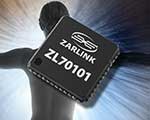|
|
|
| Information technology, patient monitoring | |
Zarlink introduces implantable wireless system-on-a-chip11 May 2007 Ottawa, Canada. Zarlink Semiconductor Inc. (NYSE/TSX:ZL) has introduced a new microchip, the ZL 70101 transceiver, an ultra low-power radiofrequency (RF) system-on-a-chip solution for use in both implanted medical devices and monitoring base stations.
Wireless data transmission Previous home health-monitoring systems required the patient to accurately position an inductive wand over the implanted device. In comparison, using Zarlink MICS technology, patient health and implanted device performance data can be stored in the implanted medical device’s memory and wirelessly transmitted to a base station, without requiring patient intervention. Data can then be forwarded over the telephone or Internet to a physician’s office. If a problem is detected, the physician will schedule a patient follow-up visit where the two-way RF link can be used to interrogate and adjust implanted device performance. During surgery to implant medical devices, the longer operating range of the ZL70101 chip allows the base station/programmer to be located outside the sterile environment. This potentially shortens surgery times and reduces healthcare costs, as programming equipment does not have to be sterilized for use in the operating room. Ultra low-power RF technology is also enabling a range of new diagnostics and therapies, including implanted devices used to monitor and treat diabetes, neurostimulators that alleviate chronic pain or lessen the debilitating effects of Parkinson’s disease and dystonia, and gastric stimulators that may offer a viable alternative in the treatment of obesity. “As in-body communication systems evolve to support advanced diagnostics and therapies, it’s critical that radio performance does not impact the battery life of an implanted medical device,” said Steve Swift, senior vice president and general manager, Ultra Low-Power Communications, Zarlink Semiconductor. “The ZL70101 transceiver offers unparalleled data rates and ultra low-power consumption performance in a highly integrated package, backed by Zarlink’s established expertise in meeting the unique quality requirements for devices intended for human implant.” Ultra low power sleep mode To help conserve implanted medical device battery life, in-body communication systems transmit data on a scheduled or as-required basis. The ZL70101 transceiver incorporates a unique “wake-up” receiver that allows the integrated circuit to operate in an extremely low current 250 nA (nanoamp) “sleep” mode. Communication is then initiated using a specially coded wake-up signal from the base station transmitter. The implanted medical device can also wake up the ZL70101 radio on detection of an emergency medical event. An emergency signal could then be sent to the base station, which in turn could directly alert paramedics. When in full operation the ZL70101 typically consumes 5 mA (milliamps) of supply current. By using the high data rate with heavy duty-cycling, the average power consumed by the ZL70101 can be very small. This conserves overall implanted medical device battery life.
|
 Building
on Zarlink’s MICS technology platform, the ZL70101 transceiver chip delivers
high data rates, low power consumption and unique wake-up circuitry. The new
chip will allow medical device manufacturers to design in-body communication
systems that will improve patient care, lower healthcare costs, and support
new monitoring, diagnostic and therapeutic applications.
Building
on Zarlink’s MICS technology platform, the ZL70101 transceiver chip delivers
high data rates, low power consumption and unique wake-up circuitry. The new
chip will allow medical device manufacturers to design in-body communication
systems that will improve patient care, lower healthcare costs, and support
new monitoring, diagnostic and therapeutic applications.